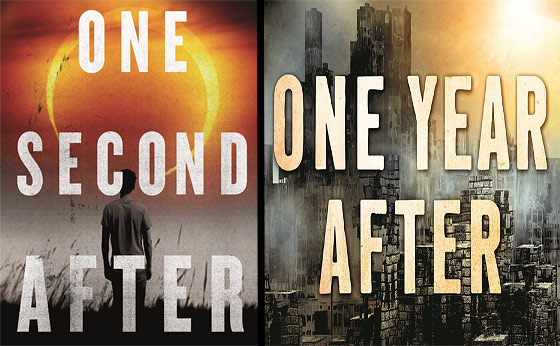Cataclysmic EMP Grid Collapse – Former CIA Director Sounds Alarm

(image: William Forstchen novels)
The following are statements made by former Central Intelligence Agency (CIA) director James Woolsey during an interview via forbes.com regarding America’s power grid security and the fact that it is the nation’s proverbial Achilles heel.
Among all the dangers posed to the grid (cyber-attack, solar flares, conventional bombing of critical substations), an electromagnetic pulse (EMP) may lead to a cataclysmic collapse that could plunge the nation into the dark for months, possibly even years, with no way to restart the system and little (or no) ability to investigate the type or source of the event.
While an EMP detonation may seem far-fetched, it is a “real and credible threat to the grid”.
Here’s what the former CIA director said:
While the forbes.com interview took place during December 2014, the message remains exactly as relevant and important today. The following paragraphs are excerpted statements by director Woolsey – who is also the co-founder of the United States Energy Security Council and has testified before Congress on multiple occasions on the danger posed by an EMP attack.
Begin –
The destructive force of an EMP could knock out the grid for a year, maybe even longer. That’s because the parts needed to fix the transmission lines and transformers destroyed are bespoke, with many only made in two places, South Korea and Germany.
The EMP Commission, which was set up after 9/11, estimated that within 12 months of an EMP event, two-thirds of the US population would likely perish from starvation, disease and societal breakdown. Other experts estimate the likely loss to be closer to 90 percent.
William Forstchen’s novel, One Second After, gives a chilling portrayal of what life may look like after an EMP detonation. It describes a population totally unsuited for living in the dark. Deaths come in waves; first the elderly and then those who depend on medication. Following that are those who die of simple diseases, like typhoid or dysentery, as well as those who have no survival or farming skills, though even subsistence farming would likely be a challenge given the speed in which society would collapse versus the time it takes to actually prepare fields and grow substantial amounts of food. Eventually, the few survivors in the small town who have overcome these deprivations and learned to produce food face continual security issues, having to fight off marauding bands and, interestingly, bullets become a base currency in their economy. It’s pretty bad stuff.
The EMP commission found that it took just one, low-yield nuclear detonation in the center of the country to knock out the entire US electrical grid. The explosion didn’t have to be big; it could be smaller than the blast at Hiroshima, for example. Getting it over Omaha or Kansas is a pretty simple task, easier than you may think. The North Koreans could do it. Recently, declassified documents show that the North Koreans recruited Russian scientists back in the early 1990s to build a nuclear weapon that could deliver a major EMP shot. As you know, the North Koreans now have the bomb, so delivering it may be as simple as hiding a small nuclear device in a satellite and having it detonate while in orbit over the US.
But it’s not just state actors we should be worried about. Terrorist groups, if they can get their hands on some fissile material, and they wouldn’t need a lot, could set off an EMP blast by attaching a small nuclear device to a simple weather balloon and detonating it once it gets 20 miles or so above the ground. In One Second After, the US power grid was knocked offline with just one missile launched from a cargo ship floating in the Gulf of Mexico. It really isn’t that difficult to do this.
(Regarding the Cold War strategy – prevention through deterrence) Back then, the impact of an EMP detonation was secondary to the destructive power of an all-out nuclear war with the Soviet Union. In that scenario, it was impossible to protect anything, so the focus was on deterrence through mutually assured destruction. That’s not the case today. We cannot deter this threat because it could be deployed easily by an irrational state, or potentially non-state, actors. In order to attack us, you don’t need thousands of nuclear missiles here, you just need one. And, as importantly, the effects are instantaneous and cataclysmic. So, once we have been attacked, we would have no ability to understand the origins. We simply wouldn’t know, maybe for years, if it was North Korea or a solar flare that hit us.
– End
While there are EMP naysayer’s and poo-pooers out there, I thought that the statements above might be of interest for some of you, given the source. EMP topics may appear as doom-and-gloom or end-of-the-world to some, however it is a topic that I occasionally address, given its apparent validity.
William R. Forstchen’s new book:
One Year After: A Novel
